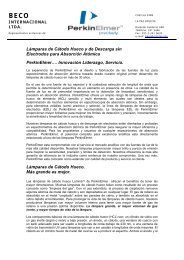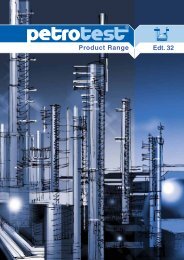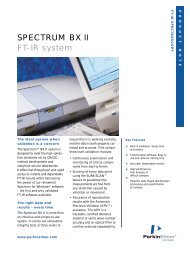General Catalogue Chemistry - BECO Internacional LTDA.
General Catalogue Chemistry - BECO Internacional LTDA.
General Catalogue Chemistry - BECO Internacional LTDA.
You also want an ePaper? Increase the reach of your titles
YUMPU automatically turns print PDFs into web optimized ePapers that Google loves.
analysis methods<br />
667 325<br />
Calorimeter for solids and liquids<br />
Used to measure the enthalpy of reaction when<br />
burning solid or liquid substances. The unit is<br />
made principally of glass. The lower section of<br />
the calorimeter is equipped with a glass inlet<br />
nipple for continuous supply of oxygen, the holder<br />
for the porcelain crucible with the product<br />
being oxidized, and the electrical lead for the<br />
incandescent wire coil required for ignition. The<br />
course of the reaction can be observed from<br />
the outside through the glass section, thus<br />
allowing for continuous control. The hot combustion<br />
gases are cooled in the double-helical<br />
heat exchanger, warming the calorimeter liquid<br />
(e.g. water) by several degrees Kelvin. The<br />
double-helical design of the heat exchanger<br />
minimizes the amount of heat lost in the form of<br />
residual heat in the combustion gases.<br />
This calorimeter is suitable not only for determining<br />
the molar combustion enthalpy of chemically<br />
defined compounds; it is just as good for<br />
measuring the calorific value of foods. There<br />
are two incandescent coils of differing diameters<br />
available, the choice depending on the<br />
ignition temperature and incineration period for<br />
the material being tested.<br />
Replacement to calorimeter 667 325:<br />
667 324 ignition coils , set of 2<br />
Measuring the combustion enthalpy of<br />
carbon<br />
sulfur<br />
sugar<br />
fats (e.g. vegetable oils)<br />
bread<br />
667 326<br />
70 LEYBOLD DIDACTIC · GENERAL CATALOGUE CHEMISTRY<br />
Calorimeter for gases<br />
Used to determine the enthalpy of reaction for<br />
gaseous substances.<br />
Two gases are caused to react inside this<br />
calorimeter and the heat of reaction is measured,<br />
e.g.<br />
hydrogen and oxygen<br />
hydrogen and chlorine<br />
carbon monoxide and oxygen.<br />
The gases are forced out of two gas syringes<br />
and through two capillary tubes into the path of<br />
an electric arc. Continuous combustion takes<br />
place here.<br />
The combustion gases and the excess of one<br />
of the reaction gases flow through a helical<br />
heat exchanger, where the heat of reaction is<br />
transferred to the calorimetric fluid, and thence<br />
into a third gas syringe (e.g. > 665 914). The<br />
amount of fluid in the heat exchanger is kept<br />
small since gas reactions using gas syringes<br />
allow only small quantities of a substance to be<br />
burned. In addition we recommend that the<br />
calorimetric liquid used be a substance of low<br />
heat capacity, e.g. trichloromethane. The<br />
temperature rise is measured with a precision<br />
thermometer (> 666 176) or temperature<br />
sensor (> 666 193) connected to the temperature<br />
measurement instrument > 666 190<br />
or > 666 210. The unit is made entirely of<br />
glass. This gives the following advantages:<br />
All the processes are visible.<br />
Heat losses are low, particularly as the unit is<br />
not in any direct contact with any metal parts<br />
(stand components).<br />
We recommend using the spark gap power<br />
supply > 667 820 to supply the arc. When<br />
using other high voltage sources please bear in<br />
mind that excess power can cause the platinum<br />
wire to melt.<br />
Complete with 5 GL 18 threaded connectors<br />
used to attach three gas syringes and the<br />
thermometer and to vent the system.<br />
667 322<br />
Calorimeter for measuring evaporation cooling<br />
Every change in state of matter requires conversion<br />
of energy. This can be measured as a<br />
change in temperature. The effect can be<br />
demonstrated and analysed quantitatively with<br />
the calorimeter. Included with the unit is a<br />
detailed description of the experiments and calculations<br />
for the calorimetric data.<br />
Advantages:<br />
Clarity for students - the unit is made of glass<br />
Resistance to chemicals<br />
Short reaction times<br />
Low heat losses<br />
Determining the heat of solution<br />
and neutralization<br />
Determining the evaporation cooling of<br />
media with low boiling points (e.g. alcohol,<br />
ether, water)<br />
Determining the heat of solution of gaseous<br />
ammonia in water and reversal of this reaction<br />
Demonstrating the function of a compressor<br />
refrigerator and a heat pump






